|

by Vladimir Ivanovich Vernadsky
from
21stCenturyScienceTech Website
|
In this first English
translation of a 1938 article draft, Vernadsky proposes
that living matter exists as droplets of a Riemannian
space, dispersed within the Euclidean space of the inert
matter of the biosphere.
EDITOR'S NOTE
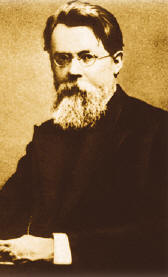 This
article is a sequel to V.I. Vernadsky's 1938
work, "Problems of Biogeochemistry II: On the
Fundamental Material-Energetic Distinction Between
Living and Nonliving Natural Bodies of the Biosphere,"
which was published in the Winter 2000-2001 issue of
21st Century Science & Technology. This
article is a sequel to V.I. Vernadsky's 1938
work, "Problems of Biogeochemistry II: On the
Fundamental Material-Energetic Distinction Between
Living and Nonliving Natural Bodies of the Biosphere,"
which was published in the Winter 2000-2001 issue of
21st Century Science & Technology.
In that work, Vernadsky
developed the distinction among the three domains of
non-living, living, and noetic, the latter referring to
the human mind which, he noted, was capable by its
innate power of creativity of becoming a geological
force.
In his foreword to that 1938 work, Vernadsky promised "a
third issue now in preparation for publication," which
"poses the still more general question of the 'states of
physical space.'"
This promised "third
issue" was never completed for publication. However, the
article presented here is a translation of two fragments
from 1938, both bearing the given title.
It was translated from Russian by Peter Martinson and
Sky Shields of the LaRouche Youth Movement, and Rachel
Douglas, William C. Jones, and Laurence Hecht. It was
dedicated to Lyndon LaRouche on his 85th birthday, Sept.
8,2007.
The text which we have used as a source is from the work
Fiiosofskie knigi naturaiista (The Philosophical Books
of a Naturalist), Moscow: Nauka, 1988. That text, as
reported by the Russian editors on p. 442, is based on
the copy held in the USSR Academy of Sciences Archive,
f. 518, op. 1, item 152.
The Russian editors add:
"The work exists as
two fragments with the same title, the first of
which is evidently an initial draft. This version
was later set aside by the author, which explains
its brevity [sic; in fact, it is longer] and obvious
unfinished character. The second fragment is rather
fuller and, together with the notes VI. Vernadsky
made at the Uzkoye Sanatorium in the Summer of 1938,
treats the problem fairly comprehensively."
The reference to 1938
writings from Uzkoye Sanatorium refers to the essay
published in our Winter 2000-2001 issue. |
"In every crystal,
we
have the manifestation of a particular state of space"
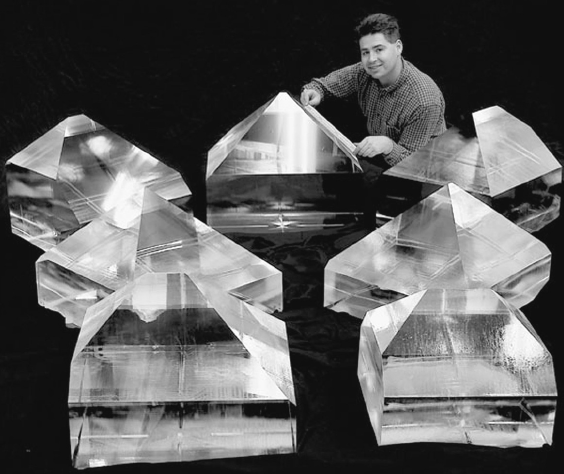
These 700-pound
fast-growth crystals
are produced at Lawrence Livermore National
Laboratory
for use in the National Ignition Facility laser.
Sliced into plates,
they convert the infrared laser light beams to ultraviolet,
just
before the beams strike the laser fusion target.
Fragment I
-
We are currently living through a
period in which scientific thought is preeminent in the life of
mankind. Presently, in connection with his scientific work, the
naturalist quite inevitably turns to a more profound, logical
analysis of the very foundations of his knowledge, which it was
no trouble for him to leave aside during the last century. The
conditions in which he is working in the 20th Century forcibly
compel him to do this; it is demanded by his concrete, daily
scientific work, and by his methodology of experimentation or
observation.
The following circumstances, which are independent of the
naturalist's will, require it.
First and foremost among these is a phenomenon, absolutely
exceptional in the history of science, which is currently being
experienced in the natural sciences—in the broad sense—and is
leading to their radical reconstruction, opening up for
scientific thought completely new pathways of investigation and
progress, which science previously lacked.
At present, scientists, under the influence of exceptionally
important newly revealed facts, are creating new notions, which
go far beyond the limits of all previously existing ideas,
beyond the limits of the boldest and most fantastical ideas and
constructs of philosophical thought. For the first time in the
written history of humanity, science, using new, unprecedented
methods, is not merely constructing specific generalizations,
founded on and originating from facts.
In addition, it is constructing new
conceptions of the world, which go far beyond the specific
facts, but do not contradict them in the way the facts are
contradicted by the scientific and philosophical notions that
reigned, unchallenged, during the 19th Century. Those notions
were developed by human culture over many centuries, and came
into scientific thought as if ready-made.
They were honed by the labor of
philosophical thought over many centuries. At the present time
they are being revised in the course of current scientific work,
and are undergoing changes that radically transform our
understanding of them. Among such concepts are time, space,
energy, life, geometry, etc.
In all of this motion that is occurring, the active source of
the change in basic concepts is not philosophy or religion, but
science. Scientific work has barely touched on these concepts
before now.
It made its way within them, not
colliding with them, yet introducing its generalizations into
them.
-
This condition of scientific thought
has coincided with the absence, in 20th Century philosophy, of
any creativity, com parable to what is emerging so clearly in
science. Scientific thought is currently influencing philosophy,
while the previous belief, that philosophy can fathom reality
more deeply than science can, is disappearing.
Philosophy is now living in the past, and it is less and less
necessary to take it into account, in the ongoing reconstruction
of the fundamental scientific understanding of reality. Science
is being deprived of the support, which the philosophical
analysis of fundamental scientific concepts provided for it
during the past three centuries.
Philosophical thought is now working a great deal on the
analysis and criticism of the fundamental propositions of
mathematics, including those of mechanics and geometry, and, in
the most recent time, also those of theoretical physics
pertaining to the atomic nucleus.1
1. The text included in
Filosofskie knigi naturalista (The Philosophical Books of a
Naturalist), Moscow: Nauka, 1988, inserts here two sentences,
typed by Vernadsky on a separate piece of paper, without any
indication of where they should go: “But I can omit
consideration of this area of physics, which encompasses our
most profound notions about the universe, just as it is
practically ignored by current scientific work in physics and
chemistry, and not only in descriptive natural science. It is at
a crossroads, and is changing almost daily.”
The entire, enormous domain of the biological and geological
sciences, which is undergoing radical restructuring, remains
essentially untouched by philosophical thought, which has
offered no independent analysis of the newly revealed phenomena.
In certain instances, even within new currents like the
realistic philosophies of holism and organicism (Whitehead), for
example, philosophical thought is essentially standing on 17th
Century ground, failing to realize the impossibility of pouring
new phenomena into "old wineskins."
Unfortunately, dialectical
materialism has also closed its eyes to those new developments,
which do not fit the framework of the philosophical conceptions
of the 1840s through 1880s, where it lives.
With the passage of
time, it seems to me, this discrepancy will increase, and
dialectical materialism's ability to grasp what is observed, or
what is scientifically created, will diminish. New, vital, and
creative work is needed, smashing the very foundations of
philosophical thought, as is now taking place in creative
scientific work. Bold and free searching is required.
There must
be a shift from interpretation of the old, and adaptation of the
old to the new, towards a critical examination of fundamental
propositions.
-
Among the new general concepts,
prompted by the facts of descriptive natural science, it seems
to me that two, in particular, ought to be given attention at
this time: [first of all,] the state of space, and, secondly,
right-handedness and left-handedness. They are closely
connected, and the fundamental one is the state of space.
The first person to touch upon this, in a profound synthetic
way, but with out giving it an in-depth analytic treatment, was
L. Pasteur; not long before his death, in the 1880's Pierre
Curie attempted to approach it later and more deeply, but never
yet as far as I know, has this concept become the object of the
systematic thought of both the naturalist and the philosopher.
Space that can be investigated empirically is distinct from the
space of geometry. That is a consequence of the inadequate depth
of geometrical analysis.
Geometrical space is isotropic; for example, it lacks any
manifestation of right-handedness and left-handedness.
This does not flow from how things essentially are, but is a
consequence of the insufficiently deep analysis of reality by
geometrical thought.
When speaking about space, the naturalist can make only partial
use of the achievements of geometry; more and more, he goes
beyond its limits in his judgments. This must be borne in mind.
Geometric space does not now embrace all of empirically studied
space—what Helmholtz called physical space.
In discussing the state of space, I will be dealing with the
state of empirical or physical space, which has only in part
been assimilated by geometry. Grasping it geometrically is a
task for the future.
The state of space is closely connected with the concept of a
physical field, which plays such an important role in
contemporary theoretical physics. The concept of a physical
field is distinguished from the concept of a state of space
essentially by its being clearly manifested in three dimensions;
that is, it coincides with geometric space.
It is also the case,
however; that a physical field is not a field in the ordinary
sense, since it often has curvature and, in a great number of
phenomena, physical fields in which lines of force are
distributed—electrical, magnetic, heat, gravitational, and
electromagnetic fields—clearly are a part of geometric space
that is delimited in an acutely different way.
We see dramatic
manifestations of such fields on a large scale, in the structure
of our planet. Among these are the Earth's electrical and
magnetic fields, and the vacuum of the ionosphere, which are
delimited by two spherical surfaces of different diameters;
another is the magnetic field of the Sun, which encompasses the
entire orbit of the Earth, its atmosphere, and the Earth itself.
In all of these cases, we are dealing with states of space,
whose properties are manifested not materially, but
energetically. In the cases encompassed by the thoughts of
Pasteur and Curie, however, we are dealing with a state of
space, which is manifested primarily in matter.
In essence, we have been dealing with such cases at every step
in natural science for a longtime, even before Pasteur and
Curie. Pasteur began to speak in terms of states of space.
Helmholtz distinguished physical space from geometric, as
possessing its own properties, such as right-handedness and
left-handedness.
As far as I know, this idea was not further
developed.
-
Crystallographers have been
encountering this phenomenon for a longtime. In every crystal,
in every inert natural body, we have the manifestation of a
particular state of space. Inside a crystal we have a
three-dimensional physical field, the properties and state of
which are determined by the phenomena of crystallization.
This is a homogeneous space, filled
continuously by pent-up crystal line forces (the chemical forces
of matter in the solid state), or atom points, which fill it
completely and regularly. The distribution of these forces can
very well be grasped as a particular case of the lines of force
in a physical field.
In essence, in homogeneous
crystalline matter—in systems of points or parallelepipeds,
continuously, uniformly embracing an entire three-dimensional
space without violating its homogeneity— we have the case of a
special, anisotropic state of space, sharply distinct from the
usual isotropic state of geometric space.
Innumerable instances
of different such states of space, which are dispersedly 2
expressed in matter, are known and conceivable in geometry.
2. Vernadsky uses the terms
“dispersny” and “dispersno” throughout this essay in a sense
that is analogous to the chemist’s “disperse phase,” where
particles (as colloidal particles) or droplets of one substance
are distributed through another substance, a condition that is
also called the “discontinuous phase.” We have opted to write
“dispersed,” rather than possible alternatives such as
“quantized” or “discrete,” which have their own special
connotations.
The geometry of these special states of space is entirely
determined by the laws of three-dimensional Euclidean geometry.
What is more, it can be said that in these spatial point
systems, in their bounded polyhedra—crystals—the laws of
geometry emerge for us with the greatest clarity.
A. Poincare expressed this
thought very clearly, when he observed that geometry could not
have been developed without solids. In crystallographic
phenomena, we are located entirely within the bounds of
three-dimensional Euclidean geometry.
In precisely the same way, we do not
go outside of its bounds in physical fields such as magnetic,
electromagnetic, and electrical fields.
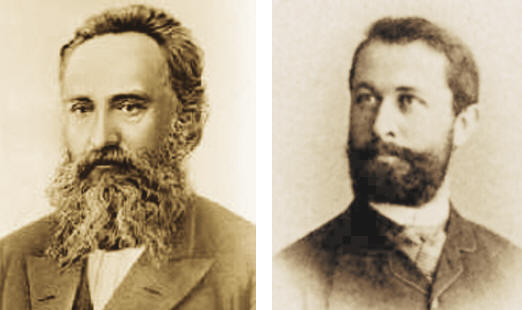
Yevgraf Fyodorov (1853-1919)
Arthur Schoenflies (1853-1928)
Fyodorov and Schoenflies encompassed “all uniquely possible
forms of an anisotropic geometric
state of space, manifested in matter,” in their studies of
crystallography.
In reality, in the profound
constructions of Fyodorov and Schoenflies, we have
a geometric expression of the structures of space, in which the
atomic manifestation of the organization of matter can uniquely
exist.
This is the only geometrically
possible expression of the atomic structure of matter, which it
expresses clearly, definitively, and precisely. In this solid
structure, in its primary manifestation, there is no motion of
atoms, such as characterizes the gaseous and liquid states of
matter.
Taking the general form of this
phenomenon, and taking into account that any chemical compound
can be manifested in the solid state in our space, we should
see, in these great, geometrically expressed generalizations of
Fyodorov and Schoenflies, a total encompassment of all uniquely
possible forms of an anisotropic geometric state of space,
manifested in matter.
-
But, in elucidating the more complex
processes of the inert natural bodies of the biosphere, it is
entirely possible (and fruitful) to use multidimensional space
to express the regular patterns that are observed when drawing
correlations between matter and its chemical composition (as
demonstrated in the works of N.S. Kurnakov and his
school, chiefly N.I. Stepanov, et al.).
But, even here we
do not go outside of Euclidean geometry.
All of these are phenomena, associated with the biosphere or the
terrestrial crust.
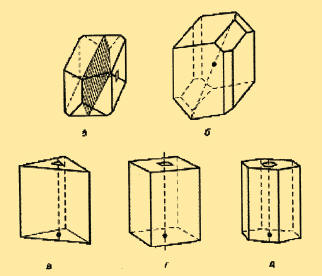
Some examples of crystalline
symmetry.
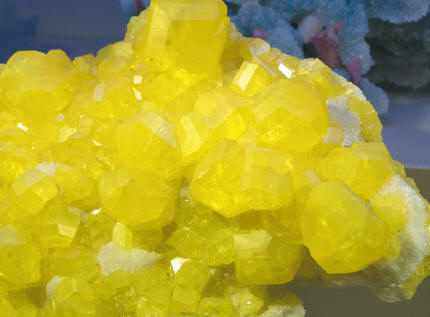
A sulfur crystal from Argent,
Sicily.
It appears that Euclidean space may turn out to be insufficient
for the geometric expression of phenomena, associated with
cosmic space.
At the very least, it was necessary to look at
those phenomena, when analyzing Einstein's theoretical premises.
(Eddington, for example, turned to them—to a certain form of
Riemannian space.)
|
"Within the boundaries of
the biosphere, which I deal with, in its inert matter,
nowhere do we have to go beyond the boundaries of
Euclidean geometry." |
-
Before continuing, it is necessary
to distinguish in what follows, whether we will be dealing in
space with material processes, or with energetic ones. From the
standpoint of the geometric properties of space, it is clearly
inevitable that they are manifested differently in space.
Geometry is not a manifestation of a priori human reason. But,
it clearly—beyond any doubt, it seems to me—follows from a study
of the history of geometry, that it grew out of the
investigation, by scientific thought, of manifestations of solid
matter in the bio-sphere surrounding man. The extension of the
laws of the biosphere to energetic phenomena came as a
consequence. Such an extension cannot shake this fundamental
feature of geometry.
Therefore we ought to view the geometric reflection of the solid
state of matter, shown by Schoenflies and Fyodorov in the most
profound and general form, as the most profound expression of
real three-dimensional Euclidean geometry.
Scientific experimentation and observation have shown that
all
energetic manifestations of the solid state of matter in space
fail to reveal the geometric properties of space as deeply as
the atomic structure of matter does.
This is a statement, in the
language of modern science, of the so-called Neumann principle,
named for the noted Königsberg crystallographer, physicist, and
mathematician [Franz Ernst Neumann].
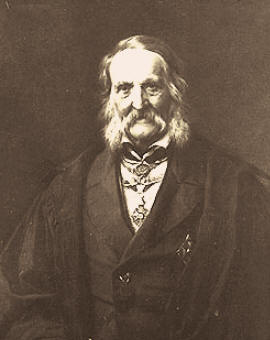
Franz Ernst Neumann
(1798-1895), German
crystallographer, physicist, and mathematician,
developed the principle that “neither the
liquid nor the gaseous state of matter is sensitive
enough for detecting the structure of space
in its geometric, rather than its dynamic manifestation.”
According to this principle, neither
the liquid nor the gaseous state of matter is sensitive enough
for detecting the structure of space in its geometric, rather
than its dynamic manifestation.3
3. The text in Filosofskie knigi
naturalista, op. cit., here reads “v vyiavlenii” (its
detection), but the sense and context require “v proiavlenii’”
(its manifestation).
Not even the
weightless fluids, to which the great physicists and
philosophers of the 17th Century reduced energetic phenomena—in
some cases quite conveniently, from a scientific standpoint—are
sufficiently sensitive.
As we are constantly saying, liquids and gases assume the forms
of the vessels which contain them, remaining inert with respect
to the space of the body. This is another expression of the
primacy of sol id material bodies for ascertaining the geometry
of an environment
In talking about space in general, we need to broaden Neumann's
crystallographic principle. Geometrically, only the study of
material phenomena—metamorphic or crystalline—can give us a
concept of the structure of space. Energetic phenomena or
phenomena occurring in liquids or gases penetrate the geometry
of space less deeply, and cannot be used to shed light on this
geometry.
Pasteur did not recognize this, when he supposed that it were
possible to create a space, characteristic of a living body, by
means of circular radiation or electric light Pasteur proposed
to conduct an experiment on a biogenesis in a medium,
illuminated by radiation from circular or elliptically polarized
light. This experiment was done later, after Pasteur. It reveals
the action of these rays upon living phenomena, but, in
accordance with Neumann's principle, it in no way alters the
structure of space.
The exposition that follows will be
based on this geometric nature of material and energetic
phenomena in geometric space. Material phenomena provide a more
profound concept of the geometric structure of space than
energetic ones do.
-
Now, we turn our attention to
phenomena of right-handedness and left-handedness, as they
relate to the laws of symmetry.
We saw that, in three-dimensional Euclidean geometric space,
right-and left-handedness are geometrically and physically
equivalent in material processes. This equivalence shows itself
in the fact that the numbers of crystallographically right- and
left-handed polyhedra that are formed during crystallization are
identical (in the absence of living organisms in the medium).
This number corresponds to the laws of the theory of
probability. When there are a sufficient number of cases, the
ratio between the quantities of right- and left-handed polyhedra
will be equal to unity. The greater the number of cases, the
more closely it will approach unity.
The observations done on quartzes by Lemmleyn in our
Bio-geochemical Laboratory, and an even greater number of cases
by Trommsdorf in Gottingen, completely corroborate this.
Pasteur's great discovery showed that this never occurs during
crystallization phenomena in living organisms, nor, even more
profoundly, during the biochemical formation of right- and
left-handed molecules in living organisms.
I fully recognize Pasteur's idea of a connection between this
phenomenon and the geometrical space of living organisms, as an
ingenious intuition. But failing to distinguish between the
material and the energetic properties of space, Pasteur
erroneously supposed that life originated on our planet in some
past period of geological history, when the Solar System passed
through left cosmic space.
He furthermore supposed that, in
cosmic space, right- and left-handed spaces are separate. As we
see, for three-dimensional Euclidean space, and for Euclidean
space in general, this cannot be the case with respect to
matter. Energetic manifestations in space do not give us the
possibility to judge.
The division into right and left,
corresponding to life, i.e., the inequalities of
right-handedness and left-handedness, have to be established not
in the energetic, but in the material properties of space.
-
Geometric laws of symmetry were
constructed for Euclidean geometry and were expressed with
regard to space in a definitive form at the end of the last
century by Ye. S. Fyodorov in St. Petersburg and A. Schoenflies
in Gottingen.
They had many predecessors, such as
Frankenhelm, Bravais, and Sohnke, but they were the first to
solve the problem definitively: Schoenflies with the aid of
group theory, and Fyodorov geometrically, by the continuous
displacement of space uniformly, without empty gaps, by
parallelohedra.
The crystalline polyhedron was
discarded, and replaced geometrically by a system of points at
the vertices of parallelohedra situated in a lawful way,
but not uniformly, within the unbounded space of
three-dimensional Euclidean geometry.
Soon thereafter, Paul von Groth in Munich was the first
to point out that it flows logically from the work of Fyodorov,
that crystals are characterized in their internal structure not
by molecules, as crystallographers had thought, but by atoms.
Earlier, this had been clearly understood by Gaudin in the first
half of the 19th Century.
The discovery of X-ray crystallography
in 1911, by M. von Laue, Knipping, and
Friedrich in Munich, working with Groth, proved it
definitively.
From this we must conclude that in
physical space, the atomic state of solid matter inevitably
requires, firstly, the inseparability of right-handedness and
left-handedness and, secondly, their physical and, consequently,
chemical equivalence.
"It can be clearly seen that
between the symmetry of crystalline polyhedra and the
symmetry of living organisms, there exists a fundamental,
deep distinction"
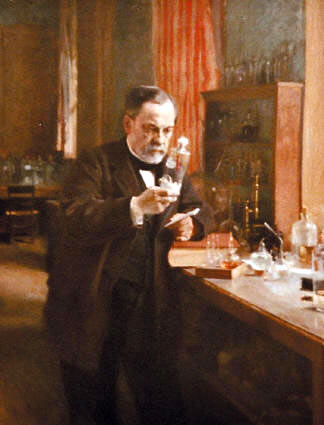
Louis Pasteur
(1822-1895) discovered left-and right-handed isomers of tartaric
acid crystals.
(These are his
sketches below.)
He found that
only the left-handed form is produced in biological processes,
such as
fermentation, while in laboratory synthesis of the compound,
equal quantities
of left- and right-handed forms occur.
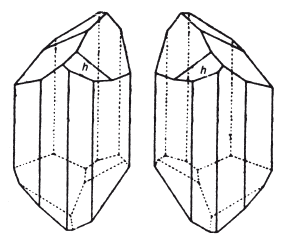
The existence of atoms in physical
space is, for us, an incontestable fact, upon which our entire
scientific conception of reality is constructed. In a solid
medium there can be no distinction between right-handedness and
left-handedness; moreover, the differences associated with
vectors in the direction of the Sun's motion across the sky, and
against the Sun, are identical in every other respect.
This is an inevitable logical
consequence of the atomic structure of matter and of
three-dimensional Euclidean geometry.
-
This conclusion requires additional
consideration. It is again useful to consider the fact that we
are dealing here not merely with the properties of crystals, but
with the distribution of atoms in spatial lattices. From this it
follows geometrically that certain elements of symmetry cannot
be manifested in atomic processes.
The first crystallographers already
pointed out that of the five regular Pythagorean polyhedra, the
regular dodecahedron is not encountered among crystals, and a
century ago Bravais proved that, accordingly, the axis of
five-fold symmetry, which characterizes the dodecahedron, could
not occur, because if it were allowed, then the law of rational
indices, which has been empirically established for crystals,
would have to be recognized as incorrect.
This is expressed clearly in the
fact that a body composed of atoms, which possesses such an axis
of five-fold symmetry, does not allow the possibility of any
arbitrary finite distance between two atom points. They will
always approach each other to a distance less than the given
distance.
Physically, we would have to be
dealing here with a continuous, non-dispersed state of solid
matter. At the same time, we can easily obtain or make a regular
dodecahedron out of any solid material.
But what's more, from
this same fundamental proposition, from the structure of solid
matter, from the homogeneous spatial distribution of atoms
having fixed finite dimensions (or possessing forces which do
not permit the penetration into their region of the influence of
the radius, strictly defined, of another atom)—from all this it
follows, on the same basis, that the number of elements of
symmetry manifested in crystalline solids is strictly limited.
No axes of symmetry greater than six
are possible in them, and none is observed. Of the innumerable
multitude of the regular polyhedra of geometry, relatively few
are encountered in natural bodies, and those consist of
homogeneously and regularly distributed atoms in
three-dimensional Euclidean space.
-
This is not only a manifestation of
the atomic structure of matter, but is also a manifestation of
the three-dimensional Euclidean space in which the bodies are
located.
From this standpoint, it becomes profoundly significant that
such a distribution of atoms is always possible in this space,
but then two physically identical varieties of helical spiral
distributions of atoms are inevitably formed—right and left.
These helical spiral distributions of atoms inevitably should be
manifested in crystalline structures, in the absence of elements
of complex symmetry, such as a center of symmetry, planes of
symmetry, or an axis of four-fold complex symmetry.
In ordinary
crystallization, the quantity of such differently oriented
helical spiral atoms will always be identical, and will be
randomly determined.
The violation of this principle in
living natural bodies, discovered by Pasteur, poses the question
of what the cause of this phenomenon might be.
It cannot, of course, contradict the atomic structure of matter,
which is so sharply and definitely manifested in living natural
bodies, where, perhaps, atomic properties are manifested even
more profoundly than in inert natural bodies.
The cause may lie either in special manifestations of symmetry
in living organisms, or in special properties of the space,
occupied by bodies of living matter.
These are the theoretically possible premises, which are really
associated with the concept of living matter as the totality of
living organisms. Thus, I avoid the slippery terrain of the
properties of "life."
In reality, in the biosphere, this
is precisely how we study the phenomena and manifestations of
life—only as "living matter."
-
Before going further, it is
necessary to pause and consider the phenomena of symmetry as
related to the living organism. The very concept of symmetry
took shape in the course of studying living organisms.
Several
centuries B.C., according to tradition, Pythagoras of Rhegium
created the concept and the word "symmetry" to express the
beauty of the human body, and beauty in general. Here the
ancient Greeks had already found lawful numerical patterns,
which thereafter, and to this day, have not yielded to the grasp
of a generalization in mathematical thought.
When, in the first ha If of the 19th Century, Brava is
approached the concept of symmetry, he proceeded simultaneously
from the symmetry of crystals and the symmetry of living
organisms. He achieved brilliant results for crystals, thus
beginning the discipline of crystalline symmetry, which led, at
the end of the century, to a well-formed system of spatial atom
points and to the complete description of their geometry.
Illness cut short his work on the symmetry of living organisms.
Nobody afterwards investigated it as deeply as Brava is had
done, and it has remained in a state of chaos to the present
time.
It can be clearly seen, however, that between the symmetry of
crystalline polyhedra and the symmetry of living organisms,
there exists a fundamental, deep distinction. In the first case,
we are dealing with the expression of the atomic structure of
solid matter, while the second involves a striving towards
organization on the part of living matter, which exists in an
isolated and separate way within the alien, inert environment of
the biosphere.
Symmetry here is expressed in the external form of that
eternally mobile, dispersed element of living matter—a large or
a negligibly small living organism—which is created and
maintained by the biogenic migration of atoms, and is revealed
as a body that is sharply distinct from the nature surrounding
it.
Symmetry is expressed also in its internal structure, its
organization, and its macroscopic and microscopic
cross-sections.
-
The laws of this symmetry are
completely unknown to us. But, its existence, the existence of
morphological regularity, is beyond any doubt. It is clear that
this symmetry obeys entirely different laws than those that
crystalline symmetry obeys.
Geometrically, two phenomena are immediately striking. First of
all, living organisms exhibit five-fold or higher than six fold
axes of symmetry. This indicates that we are not dealing here
with the symmetry, or the atomic structure, of a homogeneous
solid. The homogeneity of internal structure, which is so
characteristic of crystals, is absent here.
The inside of a living organism is
distinctly heterogeneous, its atoms being in continuous motion,
never returning to the same points where they were, unlike
crystals, where the atoms do not shift for billions of years,
unless external forces cause that to happen. [Secondly,] inside
a living organism, we are dealing with an ongoing sequence of
dynamic, stable equilibrium, regulated by the biogenic migration
of atoms. In the symmetry of a living organism, we thus have to
consider a new element, motion, which is absent in crystalline
symmetry, because the atoms in crystals do not shift, and thus
they ideally manifest a solid.
It is characteristic, that the
biogenic migration of the atoms that create a living organism's
form of dynamic equilibrium occurs in a liquid or gaseous
medium—in that medium, which is the least pronounced in
expressing the geometry of the space occupied by the body of
living matter.
Finally, a third, extremely typical feature should be emphasized
here, one which is absent in crystals, and is a primary element
in the morphological form of a living organism. In the
morphology of living organisms, curved lines and curved surfaces
reign as the primary manifestations of their symmetry. In
crystalline polyhedra, essentially in the "droplets"
corresponding to crystalline spatial lattices, curved surfaces
and curved planes are secondary phenomena.
They are connected with the action
of surface forces during crystallization and in manifestations
(of forces) within the space of liquids. Among these are the
phenomena of dissolving, and the related dissolution surfaces of
crystals. These curved surfaces are even more pronounced in all
of the energetic properties of crystals, where the polyhedron
disappears and is replaced by a sphere, a hyperboloid, an
ellipsoid, etc.
These are cases, where, in these
phenomena, Neumann's principle states that the geometric
structure of space is reflected the least.
-
In the symmetry of living organisms,
right-handedness and left-handedness are extremely pronounced,
while in crystals they are a special case, whose occurrence is
associated with the absence of complex symmetry.
But there is a fundamental distinction, as I have already
indicated, between the manifestation of right-handedness and
left handedness, with respect to symmetry, in organisms and its
manifestation in crystals. This distinction consists in the
physical-chemical equivalence of right-handedness and
left-handedness in crystals, which is manifested in their
occurrence in equal numbers during the crystallization of right
and left forms.
This always happens and, as I
indicated in Section 8, may be viewed as a manifestation of the
atomic structure of matter in the solid state in
three-dimensional Euclidean space. This is as much a property of
symmetry, as it is a property of three-dimensional Euclidean
space.
We observe something else entirely, in living matter.
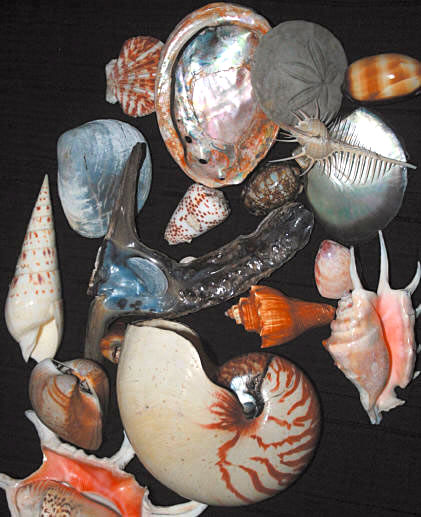
Spirals in mollusk shells.
Vernadsky notes the inequality of left and right spirals, and
the inadequacy of explanations of the phenomenon.
Here the inequality of
right-handedness and left-handedness is acutely manifested.
There is an enormous accumulation of material that has still not
been worked through critically, but it seems to me that it can
be firmly established on the basis of this material, that in
organisms—in living matter— this inequality is extremely
pronounced for a whole range of diverse properties. It is
transmitted hereditarily and is a species marker.
All proteins exhibit a left rotation
of the plane of light, both in animals and in plants. This means
that, in the complex matter of living bodies, only left isomers
in protein bodies—the principle component of protoplasm—are
stable. Right isomers are absent. As Pasteur demonstrated, all
crystalline compounds—alkaloids, glucoses, sugars, etc., which
make up eggs or grains, i.e., which are the most essential for
life—are left-handed.
This last assertion would require
more detailed discussion, which I cannot go into in this short
article. But, in general, it seems to me to be true, and
sometimes difficulties may occur only because the complex
organic compounds in bodies of living matter have right and left
complexes simultaneously as their components. This situation
requires verification, beginning with the critical processing of
all the material.
No less pronounced is the chemical distinction of the action of
right and left isomers upon cell protoplasm.
A series of precise experiments in this area, designed by G.F.
Gause partly in connection with the work of our laboratory,
has recently demonstrated this beyond the shadow of a doubt.
Right and left chemical compounds act here in an identical
setting and under identical conditions, in the complex
thermodynamic environment of living matter, as bodies that are
chemically acutely different.
They point to a unique geometric
structure, which is dynamically manifested differently for right
and left [isomers] in a living organism, and in a cell, in
particular.
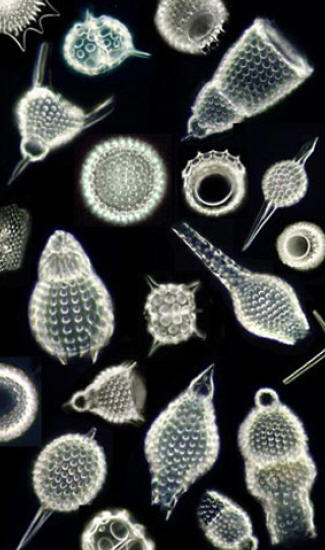
Radiolaria are
single-celled marine organisms with intricately
detailed glass-like exoskeletons. These mixed radiolaria were
microphotographed with dark-field illumination.
The inequality of right-handedness
and left-handedness is expressed not only in their chemical and
physical manifestations.
It embraces the entire morphology of
the organism and, moreover, its dynamics. Extraordinarily
characteristic is the significance of spirals in the form of
organisms, and the inequality of right and left spirals. This is
expressed in the inequality of the right and left coils in
shells, bacteria, seeds, plant tendrils, etc. It is seen in the
rare occurrence of "left-handed' organisms although, for certain
organisms, they predominate and can be taken as a species
marker.
I am leaving completely aside the numerous and various
explanations of this general phenomenon.
They are formulated from case to
case and, in general, it seems to me that they explain nothing.
Fragment II
-
The state of space is closely
associated with the concept of a physical field, but is
distinguished from the latter, in that it is clearly manifested
in three dimensions. But a physical field, too, for example an
electromagnetic field, actually has curvature, and phenomena
within it do not occur on a plane. In the ionosphere, we have a
very pronounced, peculiar state of the space of this terrestrial
envelope, a special physical field—the field of a physical
vacuum in the form of a three-dimensional space, bounded by
spherical surfaces of different radii.
In reality, we encounter different states of space at every
step. Thus, inside a crystal we have a three-dimensional
physical field, whose properties are determined by the phenomena
of crystallization. This is a homogeneous space, filled
continuously by pent-up crystalline forces (the chemical forces
of matter in the solid state), by atom points, which fill it
completely and regularly.
In essence, in homogeneous
crystalline matter—in systems of pints or parallelepipeds,
continuously, uniformly embracing an entire three-dimensional
space without violating its homogeneity—we have the case of a
special, anisotropic state of space, sharply distinct
from the usual isotropic state of geometric space.
Hundreds of
such different sees of space, expressed in different ways in
dispersed matter, can be distinguished geometrically. But the
geometry of these special states of space is entirely determined
by the laws of Euclidean geometry. Likewise, in magnetic,
electrical, and electromagnetic fields we do not go outside the
boundaries of Euclidean geometry, and remain in
three-dimensional space.
But with more complex phenomena, it is convenient and possible to
use geometrical representations of multidimensional spaces in
Euclidean geometry.4
4. Author’s note: This current of
thought has been applied with great success for correlating
chemical compounds in the work of N.S. Kurnakov, N.I. Stepanov,
and the school of N.S. Kurnakov.
It can be stated that in all of these phenomena, we never go
beyond the limits of the inert natural bodes of the biosphere.
In this domain of phenomena, we are located entirely within
Euclidean geometries. These Euclidean geometries are expressed
in three-dimensional geometry in the anisotropic spaces of
crystallography, while in expressions of the correlation of
chemical properties and matter in the conceptions of Kurnakov,
they are expressed in three-dimensional, four-dimensional,
five-dimensional, and more complex geometries.
One might think, that nowhere within the limits of the inert
natural bodies and phenomena of the biosphere do we currently go
outside the domain of Euclidean geometry. We do not go beyond
it, until we touch upon planetary phenomena.
Evidently, these conceptions are insufficient, when we go beyond
the limits of our planetary world in to cosmic space.
But these phenomena, which are associated with Einstein's ideas,
lie outside of my purview, insofar as I am dealing with the
inert and living natural bodies of the biosphere, which is one
small envelope of our planet.
-
Yet, as soon as we approach living
natural bodies, we encounter a fundamental change in the
geometric phenomena, which, it seems to me, does not fit into
the confines of Euclidean geometry of any number of dimensions.
Basic here is the marked violation of, firstly, symmetry, and,
secondly, the manifestations of right-handedness and
left-handedness.
Geometrically, the laws of symmetry were constructed for
Euclidean geometry, and they were expressed not only
geometrically, but also algebraically, in the theory of groups,
and the same results were obtained by these two independent
logical paths. Geometrically, they came out of the distribution
of the points of space, where these points always had a certain
parameter, a certain interval, closer than which they could
never approach each other.
In the phenomena around us, which can
be reduced to points, i.e., to the atoms which comprise matter,
nowhere do we encounter any violation of the laws of symmetry.
These laws are violated within the boundaries of the space
occupied by living matter, where by "living matter" I mean the
totality of all living organisms.
This violation is most vividly
expressed by the acutely different manifestation, inside the
bodies of living organisms, of right-handed and left-handed
crystal lattices (having right-handed and left-handed internal
atomic structure) for one and the same chemical compound, and
these turn out to be chemically very different.
-
Unfortunately, these phenomena of
symmetry and the phenomena of right-handedness and
left-handedness—the former encompassing all of the basic
geometric and physical patterns of sol id matter, and the latter
characterizing the bodies of living organisms—remained for a
longtime, and in part still do remain, outside the purview of
mathematicians and philosophers.
One might say that there has been no philosophical analysis.
But, mathematical analysis (both geometric and algebraic) of
dispersed regular systems of atom points was done brilliantly,
one might say definitively, in the work of S. Fyodorov in
St. Petersburg and A. Schoenflies in Gottingen at the end
of the 19th Century.
In the course of this work, incidentally,
it was determined that far from all of the geometrically
conceivable polyhedra are encountered among the inert natural
bodies of our planet. In particular, one of the five Pythagorean
solids, the regular dodecahedron, is not and cannot be observed
among the inert natural bodies of the Earth's crust.
This is a consequence of the
dispersed structure of solid chemical compounds: they are
composed of atoms which can never approach one another to a
distance less than a given magnitude, which is different for
each isotope.
Another geometric consequence of that same basic
phenomenon is that in the geometric structures of matter—in
crystals and molecules—five-fold, seven-fold, and higher-order
axes of rotational symmetry cannot exist.
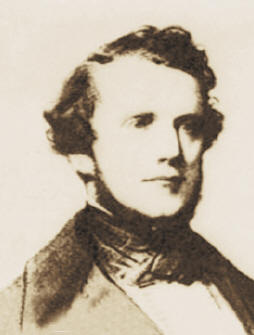
Auguste Bravais (1811-1863), a
geometer
and naturalist, studied the question of symmetry
from the perspective of biology, but illness
cut short his life and work. “It seems to
me that nobody has gone beyond Bravais,”
Vernadsky writes.
The phenomenon of symmetry, which
has only partly been grasped by mathematical thought, came into
science in connection with the sense of beauty that developed in
humanity many thousands of years ago. This concept was a
creation of Hellenic thought in the first millennium B.C.
Tradition has preserved the name of Pythagoras of Rhegium, who
first identified it. But in science, the concept of symmetry
arose in the 17th Century and, in a more general form, in the
18th and 19th centuries. It had two roots. On the one side, it
emerged from the observation of inert natural bodies of the
biosphere—snowflakes and crystals—and, on the other side,
chiefly with Bravais in the middle of the 19th Century, from
observation of the forms of living organisms.
Bravais, who
approached the study of crystals from the standpoint of his
primary scientific interest in biology, laid the basis for the
geometric study of crystalline symmetry, and, at the same time,
demonstrated the essentially different character of the symmetry
of organisms, compared with crystals. But his work, the work of
a profound geometer and naturalist, was interrupted in its prime
by an incurable illness.
The thread that he let go was not
picked up by anyone. As far as geometry is concerned, the
symmetry of living organ isms is in a state of chaos. The
assembled facts have not been embraced by geometric thought.
It
seems to me that nobody has gone beyond Bravais.
Amazingly, the concept of symmetry has remained outside the
reach of philosophical thought, and it seems to me that its
significance has been insufficiently deeply considered in
science, despite its fundamental significance being clear to
many, and despite the obvious possibility of further
mathematical investigation.
-
Matters are even worse with the
concept of right-handedness and left-handedness, whose enormous
significance and very different manifestation in living and
inert natural bodies were clearly brought out in the middle of
the last century by Louis Pasteur. Essentially, no one has gone
deeper than he did.
Geometers have ignored this concept.
Crystallographers ascertained that it is expressed in the
right-handed and left-handed helical spirals, in which the
isotopes [sic] are distributed in crystalline structures.
Pasteur was the first to prove that the same phenomenon must be
observed in certain chemical compounds in molecules.
From his
observations, he drew the correct conclusion that there is a
pronounced difference in how these phenomena are expressed in
living and inert natural bodies. The laws of symmetry, derived
on the basis of the study of crystals, are sharply violated in
living natural bodies.
Pasteur, like Bechamps somewhat before him, understood the
significance of right- and left-handedness, based on the
observations made by technicians in Alsace, who had obtained
left tartaric acid and its salts through the action of living
mold on
racemic acid
and its salts. Most likely Pasteur was
right (unfortunately, this has not yet been conclusively
verified), that, contrary to the laws of symmetry, all of the
main compounds necessary for life, when crystallized (compounds
that are components of seeds, eggs, spores, and so forth), are
observed only in the form of left isomers.
Non-crystalline—colloidal or mesomorphic—proteins are always
left-handed. To date, right-handed isomers of proteins and the
main crystalline products of their decomposition have been
obtained only in the laboratory.
In the plant and animal worlds,
only the left isomers are observed.
This is expressed in the special characteristic of living
organisms, namely, feeding on, and converting into their bodies,
right-handed isomers. Only left-handed isomers enter into the
composition of a living body. This explanation is a simple
statement of fact and, essentially, cannot be considered an
explanation. It is just as incomprehensible to us as the fact
itself.
-
Since the right-handedness and
left-handedness of crystalline solids in three-dimensional
Euclidean space are chemically identical, the question
inevitably arises of whether or not the fact, grasped by
Bechamps and Pasteur, and independently demonstrated earlier by
Bechamps, is explained by assuming that living organisms have a
special, poorly understood property, by which they violate the
equivalence of right-handedness and left-handedness, and
construct their bodies from left isomers of the basic molecules
necessary for life.
Isn't that a tautology? And would it not be
more correct to turn, as Pasteur did, to the properties of the
spaces, in which life takes place and in which it originated?
Certainly right-handedness and left-handedness in Euclidean
space are a geometric property of that space. That is evident
from the geometrical finding, shown long ago, that
right-handedness and left-handedness are not manifested in the
fourth dimension of Euclidean space. Kant already studied this
phenomenon, and he emphasized that right and left hands coincide
in four-dimensional Euclidean space. It is clear that
right-handedness and left-handedness are characteristic of
Euclidean spaces of odd-numbered dimensionality.
It is clear from the properties of symmetry mentioned earlier,
that it is not only a physical-chemical property, since the
equivalence of right-handedness and left-handedness in all of
their manifestations, whether those be geometric or
physical-chemical, is found for a homogeneous system of points,
continuously filling all of three-dimensional Euclidean space.
This follows inevitably from the constructions of Schoenflies
and Fyodorov. Pasteur did not know this.
But with the intuition of genius, he
understood the profundity of the phenomenon he was dealing with.
And he looked for a way out, in the properties of cosmic space.
He suggested that in some past period of geological history, the
Solar System had passed through left cosmic space, and that life
had originated at that time, and reflected this phenomenon.
But Pasteur did not know the
geometrical consequences, which follow from the work of
Schoenflies and Fyodorov—the geometrical equivalence of
right-handedness and left-handedness in three-dimensional
Euclidean space—and which are geometrically expressed in spatial
lattices of atom points.
From this it follows that the
equivalence of right-handedness and left-handedness may be
considered to be a geometrical property of three-dimensional
Euclidean space.
-
In order to explain the inequality
of right-handedness and left-handedness and the pronounced
manifestation of left-handedness in chemical compounds within
the bodies of living organisms, we have to suppose either that
we are not dealing with Euclidean space in this case, or that
organisms possess a special ability to utilize 5
right isomers when constructing their bodies, while left isomers
are deposited inside the bodies of living organisms.
5. One of the editions we
consulted changes “utilize” to “ignore,” but Vernadsky’s
manuscript says “ispol’zovat,” which means “to use.”
It seems to me to be simpler, before assuming the existence of a
phenomenon we don't understand and looking for it among the
properties of "life," to be persuaded of the possibility of
there existing a space, in which geometrically right isomers
would be chemically stable, while left isomers could agglomerate
in chemical processes.
L. Pasteur supposed the existence of such a space. Essentially
he supposed, that in this instance there exist separately two
analogous spaces—two isomers, in a sense—in the Cosmos: right,
and left. He took this space to be Euclidean.
But, right-handedness and left-handedness are inevitably
geometrically equivalent in Euclidean space. There would have to
be some cause for the division of space into right and left as
two independent spaces. Pasteur proceeded empirically, beginning
with how racemic crystals and molecules break down into
optical isomers. But, to this day, we know of this phenomenon
only within living organisms or in their presence.
Indeed, in his last work, Pasteur
attributed the spontaneous breakdown of
racemic acid into right and
left tartaric acid during crystallization, to the presence of
invisible organisms in the solution. He thought that
experiments, such as no one had yet done, needed to be designed
to resolve this question.
The notion of such a thing being possible in Euclidean space of
an odd number of dimensions seems improbable, for reasons that
follow, if we assume that the identity of right-handedness and
left-handedness is a geometric property of three-dimensional
space. This is demonstrated by the identical stability of
structures of matter made from the same chemical compound, with
either right or left helical spirals of homologous atom points,
completely filling the space.
As long as right-handedness and
left-handedness have not been studied as a geometric property of
three-dimensional Euclidean space, I believe I may take this
proposition as a premise in my reasoning.
But for radiation of a non-material nature, we have instances of
three-dimensional space, in which such a division of right and
left spaces easily occurs.
Pasteur already drew attention to
them, and thought that they could be used to create a medium for abiogenesis. A gaseous medium or a vacuum, illuminated by light
with right or left elliptical or circular polarization, would be
such a state of space. Here we are dealing with two separate
media—right, or left. But living beings involve a material
medium, not an energetic one. Only experiment can resolve the
matter.
Unfortunately, these relatively easily accessible
phenomena have not been studied experimentally at all.
This being the state of our knowledge, it seems to me to be
logically more correct, in geometric problems that have been
basically empirically validated throughout the entire existence
of humanity, and were constructed by humanity, not to equate,
for solids, the material and energetic estates of space with
respect to their logical consequences.
Thus, I shall proceed from the assumption that the equivalent
manifestation of right-handedness and left-handedness for
natural bodies in the space they occupy is a geometric property
of three-dimensional Euclidean space.
The absence of this equivalence, and the pronounced
manifestation of left-handedness in the material substrate of
living matter and of right-handedness in its functions, indicate
that the space occupied by living matter may not correspond to
Euclidean geometry.
Before taking up this subject, we must discuss the problem of
the symmetry, characteristic of living matter.
-
The problem of the symmetry,
characteristic of living organisms, absolutely cannot be solved
within the bounds of the symmetry that was developed for
crystalline bodies. This symmetry, which is so striking, must be
expressed essentially in some other way.
The point is that in the morphology of living organisms, we do
not see straight lines. Where we do encounter them, for example,
in sponges or
Radiolaria, it is when crystallization
phenomena are involved.
At the same time, we encounter here
instances of five-fold symmetry, such as in starfish or
Ophiuroidea.
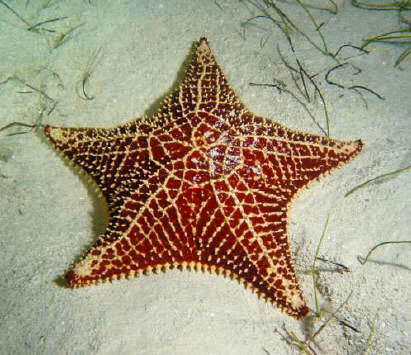
The five-fold symmetry of the
starfish Ophiuroidea.
This photo was taken
on the sea floor with an underwater camera.
This entire domain of phenomena,
which clearly involves geometry and symmetry, remains at a
standstill, and we have not found ways to express it
mathematically.
All investigators interested in the form of living organisms
have turned their attention to two extraordinarily
characteristic phenomena. The first is their dispersedness,
meaning their sharp delimitation from their environment, in
which they seem to represent bodies that are independent,
constantly moving, and set sharply apart from their
surroundings. It is as if they were special little alien worlds.
Their sizes range from 10-6
centimeters to 103 centimeters. Their del imitation
from their environment is unusually pronounced, and is beyond
any doubt. The states of space, occupied by the bodies of living
organisms, differ fundamentally from the states of space of the
inert natural bodies of the biosphere around them.
Living organisms are created in the
biosphere only from living organisms. Never from inert bodies of
the biosphere.
The form of their del imitation is clearly regular and
symmetrical, and they are always delimited by curved surfaces.
There have been attempts to explain this form as a manifestation
of particle forces, developing at the boundary of the gaseous
and liquid medium in which the organisms exist and with which
they are connected by the continuously occurring biogenic
migration of atoms. Their form is unusually constant, extremely
stable over historical time and unchanging in the course of
geological time; for some living matter, it has remained
unchanged for hundreds of millions of years.
This stability of form, which essentially expresses for us, in
living matter, the continuous motion of atoms, and the dynamic
equilibrium of atoms that is continuously maintained by that
motion—in the form of an organism, rather than a mechanism—
cannot be entirely determined, in a fundamental respect, by
surface forces, but, rather, depends fundamentally upon deeper
properties of matter (at the level of atoms or even isotopes).
The general similarity with the way
in which particle forces are manifested has to do with the fact
that the matter of a living organism, in which liquid water
predominates, is in a colloidal or mesomorphic state; only a
portion of the dispersed particles within it are composed of
crystalline matter, though these may play a very great role.
The symmetry that is observed, and the stability of minute
morphological peculiarities over geological time, which is
unusual in our experimental work, clearly show that deeper
phenomena than particle forces are fundamental here.
It is therefore entirely legitimate to think that we are dealing
here with a manifestation of deeper properties of matter, or,
rather, with a form of manifestation of matter, other than the
properties of atoms and isotopes, or physical-chemical
properties in general.
It is also legitimate to
advance and investigate the working hypothesis, that bodies of
living matter are fundamentally determined by the geometric
state of the space they occupy, which differs from the Euclidean
space of the inert natural bodies of the biosphere.
This space cannot be Euclidean, if only because it lacks the
equivalence between right-handedness and left-handedness that is
inevitable for Euclidean three-dimensional space.
-
We may try to detect the geometric
properties of this space.
The following properties of
Riemannian
space suggest that it will correspond to one or several of the
states of this space. Firstly, the fact that an infinite number
of Riemannian spaces can exist. Secondly, that any Riemannian
space is as if closed, but appears to be unbounded. In
three-dimensional Euclidean space, it will appear as a sphere.
Thus, it has no straight lines nor plane surfaces, but only
curved lines and curved surfaces can exist.
As we know, the symmetry of living matter reveals itself
geometrically in exactly this way within the inert
three-dimensional Euclidean space of the biosphere.
The dispersedness of living matter, and the widespread
occurrence of closed curved surfaces that are nearly spherical
or geometrically related forms, entirely support the hypothesis.
But we can deepen the geometric representation of these
Riemannian spaces that are characteristic of living matter.
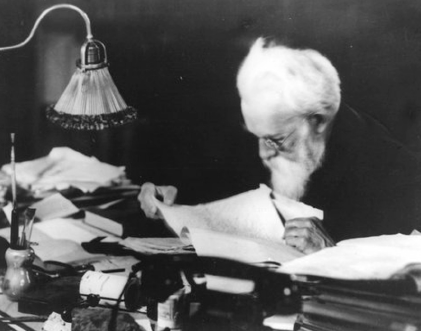
Vernadsky in his office in
Moscow in 1940.
-
Their characteristics must be:
-
In forms corresponding to this
geometry of bodies, straight lines and plane surfaces are
relegated to a secondary level. At the fore are curved
surfaces and curved lines. Obviously, in the simplest cases
in three-dimensional Euclidean space, it is convenient to
proceed from lines on the surface of a sphere and, instead
of plane surfaces, sections of its curved surface.
-
Vectors in this space must be
polar and enantiomorphous.
-
Right-handedness and
left-handedness must be pronounced, and they are not
equivalent geometrically or physical-chemically. Evidently,
left-handedness predominates in the internal structure of
living bodies.
-
In such a space, time—just as
much as physical-chemical processes—must be expressed
geometrically by a polar vector.
-
A number of very important
consequences follow, which sharply distinguish the substrate
of living matter, i.e., the state of its space, from the
state of space of inert bodies. Expressed by a polar vector,
time is irreversible in the physical-chemical and biological
processes of this space; it does not go backwards.
Consequently, entropy will not occur in matter here.
-
But a vector in this space must
not only be polar, since it is expressed in the
physical-chemical and biological properties associated with
matter. It must also be enantiomorphous, or else
right-handedness and left-handedness would be impossible.
-
This enantiomorphism is markedly
different in phenomena that are "in the direction of the
Sun's motion or against the Sun, which is connected to the
inequality of right-handedness and left-handedness.
-
The biosphere represents an
envelope of the Earth, in which innumerable minute
Riemannian spaces of living matter are included, in a
dispersed way and a dispersed form, in the states of space
of inert natural bodies with their three-dimensional
Euclidean geometry. The connection between them is
maintained only by the continuous biogenic flow of atoms.
|

 This
article is a sequel to V.I. Vernadsky's 1938
work, "Problems of Biogeochemistry II: On the
Fundamental Material-Energetic Distinction Between
Living and Nonliving Natural Bodies of the Biosphere,"
which was published in the Winter 2000-2001 issue of
21st Century Science & Technology.
This
article is a sequel to V.I. Vernadsky's 1938
work, "Problems of Biogeochemistry II: On the
Fundamental Material-Energetic Distinction Between
Living and Nonliving Natural Bodies of the Biosphere,"
which was published in the Winter 2000-2001 issue of
21st Century Science & Technology.










